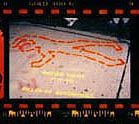31 August 2003
Where the Sidewalk Ends
A paper in the September issue of the American Journal of Public Health, “Promoting Safe Walking and Cycling to Improve Public Health: Lessons From The Netherlands and Germany” by a couple of researchers in New Jersey and Brussels examines:
“The public health consequences of unsafe and inconvenient walking and bicycling conditions in American cities to suggest improvements based on successful policies in The Netherlands and Germany.”
What they found:
 “Cyclists and pedestrians in the United States were two to six times more likely to be killed than their German or Dutch counterparts. Per kilometer traveled, U.S. pedestrians were 23 times more likely to get killed than the occupants of a car, while bicyclists were 12 times more likely to be killed.” [source]
“Cyclists and pedestrians in the United States were two to six times more likely to be killed than their German or Dutch counterparts. Per kilometer traveled, U.S. pedestrians were 23 times more likely to get killed than the occupants of a car, while bicyclists were 12 times more likely to be killed.” [source]
With this in mind and my previous post on the link between sprawl and obesity, I note that on July 24, the House Appropriations Committee voted a transportation appropriations bill out of committee that eliminates funding for the Transportation Enhancements program.
Since 1991, 10% of federal funds distributed to states through the Surface Transportation Program has been reserved for transportation enhancement activities. This meant roughly $600 million a year of federal funding for locally driven, pedestrian centered projects.
“Congress established the TE program in 1991 as a commitment by Congress to constituents that a small percentage of their gas tax dollars would be targeted to small-scale, community-initiated, locally selected transportation projects such as multi-use paths, pedestrian and bicycle facilities, historic preservation, and improvement of streetscapes and landscapes.” [source]
“Since its inception, the TE program has provided $6 billion to support 16,699 projects nationwide, including thousands of historic preservation projects. Now, Congress is acting to reverse this decade-long community building program and return to a regressive ‘roads-only’ policy.” [source]
The Rails-to-Trails Conservancy has posted a detailed state-level breakdown of projects funded under Transportation Enhancements program.
H.R. 2989, the Transportation and Treasury Appropriations Bill for 2004, actually increases highway spending to $34.1 billion — $6.1 billion more than 2003 and $4.5 billion more than President Bush’s request.
There is still hope, but we must act now. Before the full House votes on the bill it can still be amended. Congress resumes after Labor Day and is expected to vote on the bill in early September.
An amendment removing section 114 from H.R. 2989 would grant approximately $812 million to the Transportation Enhancements program. Unless reversed, individual states would be allowed to put all funds into highway projects instead of setting aside the 10% now reserved for bicycle and pedestrian projects.
See these action alerts to learn more, for contact information and talking points.
With all that’s going on, the issue is probably not high on everyone’s social justice agenda. But there’s an immediate and brief opportunity to save this great program right now.
UPDATE: On September 4 the House approved an amendment which strikes section 114 from the bill — restoring funding for the Transportation Enhancements program to the appropriations bill. On September 9, the House passed the full appropriations bill and sent it to the Senate. Thanks to everyone for taking action!

